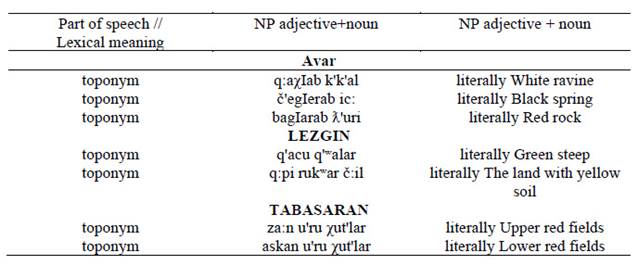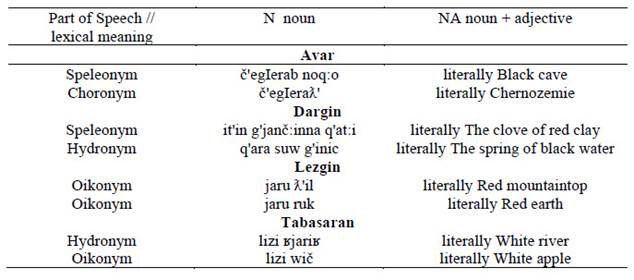Introduction
The problem of constructing the world picture is solved in modern linguistics within the framework of theoretical semantics and cognitive linguistics in the works by R. Langacker, E. S. Kubryakova, V. A. Maslova, Y. D. Apresyan, B. A. Serebrennikov, Y. N. Karaulov and others (Leontovich, 2011; Maslov, 2004). If we consider the problem of construction from the point of view of the specifics of cognitive perception of life by specific people, then the world picture as a category of linguoculturological and historical-ethnological necessarily includes the ways of language conceptualization of the region (Santueva, 2018). The importance of the study of the language conceptualization of a region is determined by the approach to language as a social and cultural phenomenon (Shikhalieva, 2019). It includes both explicit and potential knowledge of the language conceptualization of a region with hierarchical types of asymmetry - S sentence ≥ N (translation of a noun) ∓ NP (translation of a nominal group). The key terms of cognitive linguistics are related to cognitive activity of human consciousness, i.e. activity, as a result of which a person makes a certain decision or some activity. Cognitive activity is intended to describe the processes that accompany the processing of information, adjust the creation of language structures "class ↔ class member" (Melchuk, 1998). Having insight and understanding of the hierarchical relations of a particular linguocultural community, we will try to differentiate rational elements of the anthroponymic class in the system of rules that generate cognitive space of ordered types "class ↔ class member" (Shikhalieva, 2019).
Methods
In the practice of typological studies, a method of indexing quantitative values play a special part (Dixon, 2010). The combined methods to be a synthesis of indexing approaches and author’s solutions in the field of conceptualization common in linguistics are used in the paper (Jons, 2009; Thomas, 2012). In terms of hierarchical asymmetry, the data instrumentarium either indicates a situation known to the addressee, or one compares this phenomenon with another phenomenon similar to it, familiar to the addressee (Balashova, 2014). The structural analysis of concept, the structural analysis of metaphor that are comprehended in traditional cognitive approaches are used. Class members are data and functions for working with this data. A class name is the name of the new data type. Thus, units of motivated names of the anthroponymic class in the Nakh-Dagestanian languages represent an evaluation of the meanings of folklore frames (Ivanov, 1989; Haspelmath, 1993). The procedure for analyzing the terms with types "Dagestanian ≥ national languages" means the type of hierarchical relations "class ↔ member of the class", where the class is anthropos (Kibrik, 2003). Using the classes of anthropos, the properties of anthroponymic objects are determined (see Table 1):
Interpretation of Research Results
Not only the definitions of verbal communication, but also the interpretation of stereotypes of the surrounding world indicate to a convincing connection of a person with representatives of the meanings of color. The interpretation of color stereotypes in the linguistic image of the region allows for the classification of the representatives of meanings with the exchange of verbal communication of the Dagestanian linguistic and cultural community (Kibrik, 2010) (see Table 2):
As shown by the examples, adjectives with a noun play the role of determining the quality of a proper name (person). In all examples, the characteristic of quality and color is combined with the proper name (of a person) (Klimov & Khalilov, 2003). This perception of knowledge is correlated with the definitions of interpretations of terms in the Avar and Tabasaran languages. The first component can perform either descriptive, restrictive, or characterizing function. The second component describes the meaning of the name in the field of human being (Maslov, 2004).
The monuments of folklore texts with a variety of perceived and observed phenomena of communication permeate the entire sphere of human cognition. If we talk about monuments in the field of human life, then we should provide a description with the foundations of national texts "name = toponym ↔name = anthroponym" (Bagmadov, 2006; Gyulmagomedov, 2012) (see Table 3).
The study material is toponyms in which the perception of reality is reflected through color. From a linguistic point of view, these are "two-conditional attributive constructions" made up according to the model structure "adjective + noun" (Kibrik, 2010).
In the Dargin language, some toponyms are three-membered definitive phrases according to the model "adjective + genitive noun + name in the form of the absolutive" (Melchuk, 1998).
Results
The presence of evaluativity in the studied Nakh-Dagestanian languages is revealed according to the semiotic principle of folklore frames "proper name ↑ person ≥ personal name ↑ toponym". In the conceptual kernel of the Nakh-Dagestanian languages, the phenomenon of folklore frames and the opposition of precedent perception "personal name * of a person ≥ personal name * toponym" are actualized. The invariants of perception of precedent frames allow identifying the kernel of the concept and the opposition of the precedent situation (Maslov, 2004) (see Table 5).
In the notional kernel of the concept, the opposition of precedent relations of the linguistic image of the region can be re-thought. To analyze the opposition of precedent relations with the concepts of multilingual frames of color, not only the semantics of folklore but also literary texts were re-thought ↔ the color of wolf is gray color, that is, the meaning "ripe wheat". Consequently, the hierarchical structure of precedent relations systematizes the interpretation of color with the concepts of genre frames, which are comprehended, first of all, in the concept of color designations, the interpretation of frames "name is a toponym, an anthroponym" (Leontovich, 2011).
Conclusions
The linguistic image of the region in the interpretation of the frames of linguoculturology allows for the description of a multi-stage understanding of language contacts. Taking into account the fact that the frames of the observed phenomena should be disclosed in all their background and connotative meanings, it is necessary to be delicate in interpreting the material of linguoculturology with environmental factors "proper name ↕ common name" (Santueva, 2018). This multi-stage connection of the phenomena of linguoculturology actualizes the natural environment of color designations in the concept sphere of the peoples of Dagestan.



















